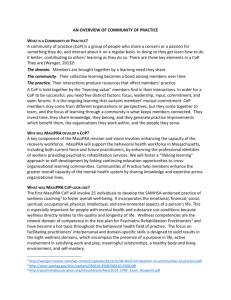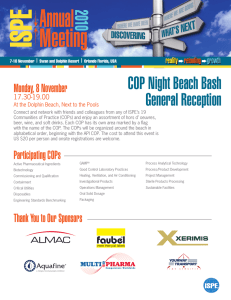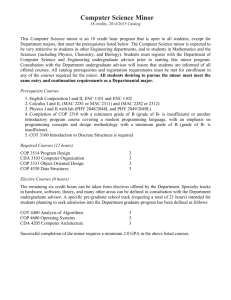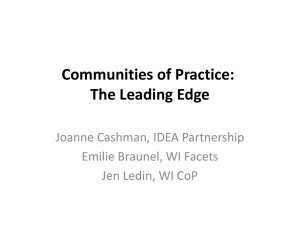Student Physics Learning Across Communities of Practice PURPOSE
advertisement
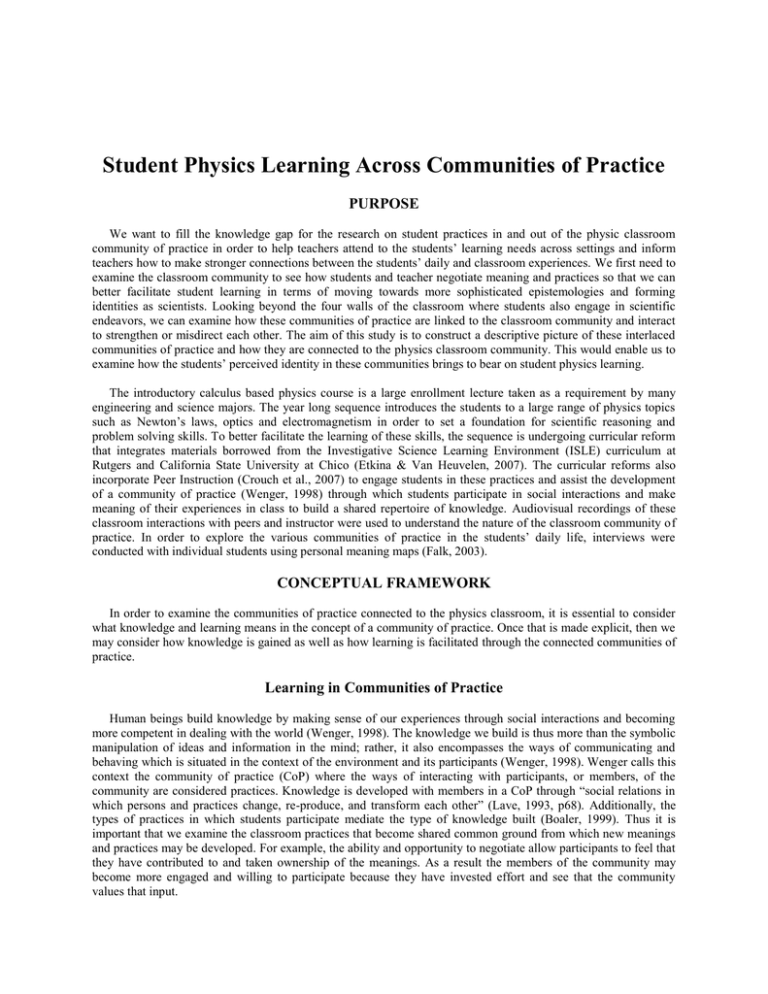
Student Physics Learning Across Communities of Practice PURPOSE We want to fill the knowledge gap for the research on student practices in and out of the physic classroom community of practice in order to help teachers attend to the students’ learning needs across settings and inform teachers how to make stronger connections between the students’ daily and classroom experiences. We first need to examine the classroom community to see how students and teacher negotiate meaning and practices so that we can better facilitate student learning in terms of moving towards more sophisticated epistemologies and forming identities as scientists. Looking beyond the four walls of the classroom where students also engage in scientific endeavors, we can examine how these communities of practice are linked to the classroom community and interact to strengthen or misdirect each other. The aim of this study is to construct a descriptive picture of these interlaced communities of practice and how they are connected to the physics classroom community. This would enable us to examine how the students’ perceived identity in these communities brings to bear on student physics learning. The introductory calculus based physics course is a large enrollment lecture taken as a requirement by many engineering and science majors. The year long sequence introduces the students to a large range of physics topics such as Newton’s laws, optics and electromagnetism in order to set a foundation for scientific reasoning and problem solving skills. To better facilitate the learning of these skills, the sequence is undergoing curricular reform that integrates materials borrowed from the Investigative Science Learning Environment (ISLE) curriculum at Rutgers and California State University at Chico (Etkina & Van Heuvelen, 2007). The curricular reforms also incorporate Peer Instruction (Crouch et al., 2007) to engage students in these practices and assist the development of a community of practice (Wenger, 1998) through which students participate in social interactions and make meaning of their experiences in class to build a shared repertoire of knowledge. Audiovisual recordings of these classroom interactions with peers and instructor were used to understand the nature of the classroom community of practice. In order to explore the various communities of practice in the students’ daily life, interviews were conducted with individual students using personal meaning maps (Falk, 2003). CONCEPTUAL FRAMEWORK In order to examine the communities of practice connected to the physics classroom, it is essential to consider what knowledge and learning means in the concept of a community of practice. Once that is made explicit, then we may consider how knowledge is gained as well as how learning is facilitated through the connected communities of practice. Learning in Communities of Practice Human beings build knowledge by making sense of our experiences through social interactions and becoming more competent in dealing with the world (Wenger, 1998). The knowledge we build is thus more than the symbolic manipulation of ideas and information in the mind; rather, it also encompasses the ways of communicating and behaving which is situated in the context of the environment and its participants (Wenger, 1998). Wenger calls this context the community of practice (CoP) where the ways of interacting with participants, or members, of the community are considered practices. Knowledge is developed with members in a CoP through “social relations in which persons and practices change, re-produce, and transform each other” (Lave, 1993, p68). Additionally, the types of practices in which students participate mediate the type of knowledge built (Boaler, 1999). Thus it is important that we examine the classroom practices that become shared common ground from which new meanings and practices may be developed. For example, the ability and opportunity to negotiate allow participants to feel that they have contributed to and taken ownership of the meanings. As a result the members of the community may become more engaged and willing to participate because they have invested effort and see that the community values that input. The chief mode of interactions in the classroom CoP is discourse, including but not limited to spoken words, facial expressions, gestures, posture and tone of voice (Norris, 2004). The social nature of learning is especially apparent when observing student problem solving in small group discussions. The result of the conversation is often a synthesis of a solution with pieces of the ideas and arguments discussed. This implies neither that the solution is comprised of all offered ideas equally nor that the solution is necessarily a correct answer. Instead, peer instruction affords the students the opportunity to collectively negotiate and share understanding of the situation to build a solution beyond what students might create individually. Studies suggest that students are able to make more diverse and deeper connections and meanings with discussion in groups compared to individually (Hatano & Inagaki, 1993). This socially constructed knowledge exists as much in each individual’s mind as in between each individual (von Glasersfeld, 1995). Because knowledge is thus constructed, adequate understanding of student learning cannot be assessed within only the individual but need to include other people and the settings. Learning Occurs Across Settings A single community of practice does not stand on its own. It is interconnected with myriad other communities of practice in which an individual is a member. Outside the classroom, opportunities for students to think about physics allow them to personally experience the ideas from class. One student interviewed said that after learning about third law pairs of forces, he consciously considered the earth pushing on him as he walked and how odd an idea that was. Just because the instructor said so and proved it mathematically in class doesn’t mean the student fully understands and believes the idea, but it does plant the seed of an idea for the student from which he can construct his understanding. The students need opportunities to personally engage the idea in multiple social interactions in order to construct their own plausible and meaningful model. To this end, the more the students can encounter and recognize the physics ideas in multiple settings, the more equipped they will be to construct knowledge that is meaningful to them. METHOD In order to examine the practices and discourse in the classroom community, audiovisual recordings of a small subset of the student group discourse during lecture were collected and transcribed. This was recorded with video cameras and wireless microphones placed on the student desks. A researcher also used a rubric to record the types of interactions and activities observed. The observation rubric was developed based on the potential interactions between teacher and student, student and student, and teacher addressing the whole class. Over time the rubric was refined by adding interactions in the learning cycle specific to the ISLE curriculum and by separating teacher addressing the class into interactions to convey information and those to manage authority issues. At the end of the three quarter physics sequence, we selected a group of students (n=6) who were considered successful in the course with a final grade of C or better. These students encompassed a range of course performance and degree of classroom participation as observed by the researcher during lecture. Each student was invited for an individual thirty minute interview conducted by one researcher. In order to examine the student’s perception of the communities of practice, the interviews were conducted using the personal meaning map (Falk, 2003) as a tool to minimize researcher bias as well as allow the student to think beyond the practices in lecture. To create the personal meaning map, the student was given a blank piece of paper with the word physics printed in the center. The student was instructed to “Write down as many words, ideas, images, phrases or thoughts as come to mind when you see or think of physics.” Ten minutes was allotted to filling out the map, and the remainder of the interview was a discussion of the contents of the map. To start the conversation, the interviewer asked about the student’s thought process while drawing the map. The conversation was student driven and open ended questions were asked for clarification. Students were allowed to describe, from their perspective, the out-of-class contexts where they do physics and the physics practices that are inherent in those communities of practice. ANALYSIS AND DISCUSSION The personal meaning maps and the audiovisual recording transcript of the interview were examined to find commonalities and differences between the students interviewed. The findings serve to paint a picture of the types of communities of practice involved and probe the student’s perceived identity in the physics classroom. Practices in the Classroom The practices developed in the classroom CoP fall into three categories. First, physics community practices include learning the physics terminology, conventions and symbolic representations while problem solving practices center on a detailed rubric provided by the teacher. These practices were dictated by the teacher and the general physics community and students are expected to acquire them with few opportunities to make their own contributions. Next, the practices that support the ISLE goals of shared authority for meaning making and communicating understanding were developed as students interacted in the classroom CoP. Students enter the community with practices of being someone who receives answers from the teacher. This conception of “being a student” was exemplified a student who said to the teacher after explaining his reasoning, “So I guess you’ll tell us another way. I was gonna say [laughs] is there a better way.” In response, the teacher reinforced the student’s authority to construct his understanding by telling him “no that works.” As the students engaged in activities where they were asked to explain and justify their ideas, they were more willing to share the authority of meaning making as authentic scientists would. S1: [Looking up at T] Will the bullet have a trajectory like that or will it just go straight? S2: The bullet’s gonna drop a little bit… S1: Yeah… T: It will drop a little bit. So you are both right, the bullet’s gonna slow down but does that tell us what’s going to happen? The first student (S1) posed the question at the teacher (T) with the expectation that the teacher is the source of “right answers.” But instead of answering right away, the teacher waited to see if others in the group would contribute. The second student (S2) jumped in right away to contribute his understanding. In this way S2 is afforded an opportunity to contribute similar to one he might encounter in a team project environment in the workplace. After the two students have voiced their thoughts, it would be typical of classroom talk for the teacher to evaluate their answers; instead, the teacher waited a moment longer which allowed for S1 to acknowledge S2. In doing so, S1 validated S2’s right to answer as a contributing member of the group. The teacher then took her turn to contribute to the knowledge building process by validating the students’ ideas and directing the task of meaning making with a guiding question. This pattern of discourse served to encourage the curricular goals of student sharing the authority of knowledge building. By having the teacher take a smaller, passive role instead of the traditional active role of knowledge provider, the role of knowledge author became available for either student in the discussion. Third, practices were developed to function in the social learning environment where discussions were more prone to be more confrontational and argumentative than normal everyday conversations. In class, students were asked to justify their answers and to critically assess the reasonings of their peers. Students were often asked to convince their neighbor of their reasoning during small group discussions. Some students reported that early in the term when the group had the same answers, they did not discuss further. Over time they found that other students have different reasonings for the same answer and they were more willing to probe deeper. This may have been due to students developing friendly relationships that were resistant to argumentative discussions that may be viewed as more hostile than everyday conversations. Beyond the Classroom Community of Practice The individual interviews showed that the predominant communities of practice in the students’ everyday life included friends, family, study groups, and other academic classes. This finding is not surprising as those are the major social interactions for college students. One student wrote a science joke on his personal meaning map and said that he often shares science jokes with his friends in study groups. This practice suggests that he is confident in his science understanding and in actively participating in his communities of practice. This is consistent with his frequent and facile participation in physics class. Humor is not the only context in which students incorporate physics. Other contexts recounted by the interviewees include physics in the news, in everyday observations, in physics demo shows, and in popular culture. These contexts provide a setting in which students can interact with members of their non-class CoP to make meaning of the physics involved. The types of non-class CoP reported by the students included the work place, family, study groups/partners, cohorts of students taking similar sequence of courses, and dorm mates. The personal meaning maps were varied in the way students expressed their thoughts in terms of representation (pictures or words) and organization (outline form, scattered around the word physics, elaborate webs connecting relating ideas). However there are also similarities in that all six students wrote down many of the concepts covered in class suggesting that their identity as physics learners are significantly grounded in practices on which they were evaluated. Additionally, each student represented some of those ideas as diagrams or graphs. This is consistent with the ISLE goal to encourage students in using multiple representations in their problem solving process. All of the students talked about physics outside of class, but while some students ventured much further beyond, others discussed physics predominantly within the class community. A surprising finding from these conversations with students was that their course grade did not necessarily correlate with genuine interest in the subject. The course grades also did not correlate with how actively they participated in the classroom practices. One student with excellent grades was a relatively passive participant who was willing to engage in discussions but rarely initiated them. During the interview she made several comments that suggest she readily accepts knowledge from authority rather than negotiates meaning to make it her own. She stated “I think our brains are kind of made to believe stuff, you know? I dunno, there is a certain amount of explanation that we need then we accept things.” Her practices during group discussions seem consistent with her view that knowledge is given to her by an authority. However, one of the goals of the ISLE curriculum is to afford the opportunities for the students to take ownership of their physics understanding. In this respect she has only made a little progress as she followed her statement of acceptance with a question and a laugh, “maybe I shouldn’t have believed it? Until I try it myself.” SIGNIFICANCE While the current curricular reforms have aided student learning in developing some practices of authentic scientists, the interview analysis revealed that participation in the class community of practice was not necessarily correlated with course performance. Rather we have to also take into account the student’s perceived identity of his/her role in the community and the settings in which he/she practices physics in order to aid student physics learning in productive participation. A more holistic view of student physic learning would help teachers attend to the students’ learning needs across settings and inform teachers how to make stronger connections between the students’ daily and classroom experiences. REFERENCES Boaler, J. (1999). Participation, knowledge and beliefs: A community perspective on mathematics learning. Educational Studies in Mathematics, 40(3), 259–281. Crouch, C. H., Watkins, J., Fagen, A. P., & Mazur, E. (2007). Peer Instruction: Engaging Students One-on-One, All at Once. Reviews in Physics Education Research, 1. Etkina, E., & Van Heuvelen, A. (2007). Investigative Science Learning Environment–A Science Process Approach to Learning Physics. PER-based reforms in calculus-based physics. College Park, MD: AAPT. Falk, J. H. (2003). Personal meaning mapping. Museums and creativity: a study into the role of museums in design education. Powerhouse Publishing, Sydney. Hatano, G., & Inagaki, K. (1991). Sharing cognition through collective comprehension activity. Perspectives on socially shared cognition, 331–348. Norris, S. (2004). Analyzing multimodal interaction: A methodological framework. Routledge. von Glasersfeld, E. (1995). A constructivist approach to teaching. Constructivism in education, 3, 15. Wenger, E. (1998). Communities of practice: learning, meaning, and identity. Cambridge University Press.

